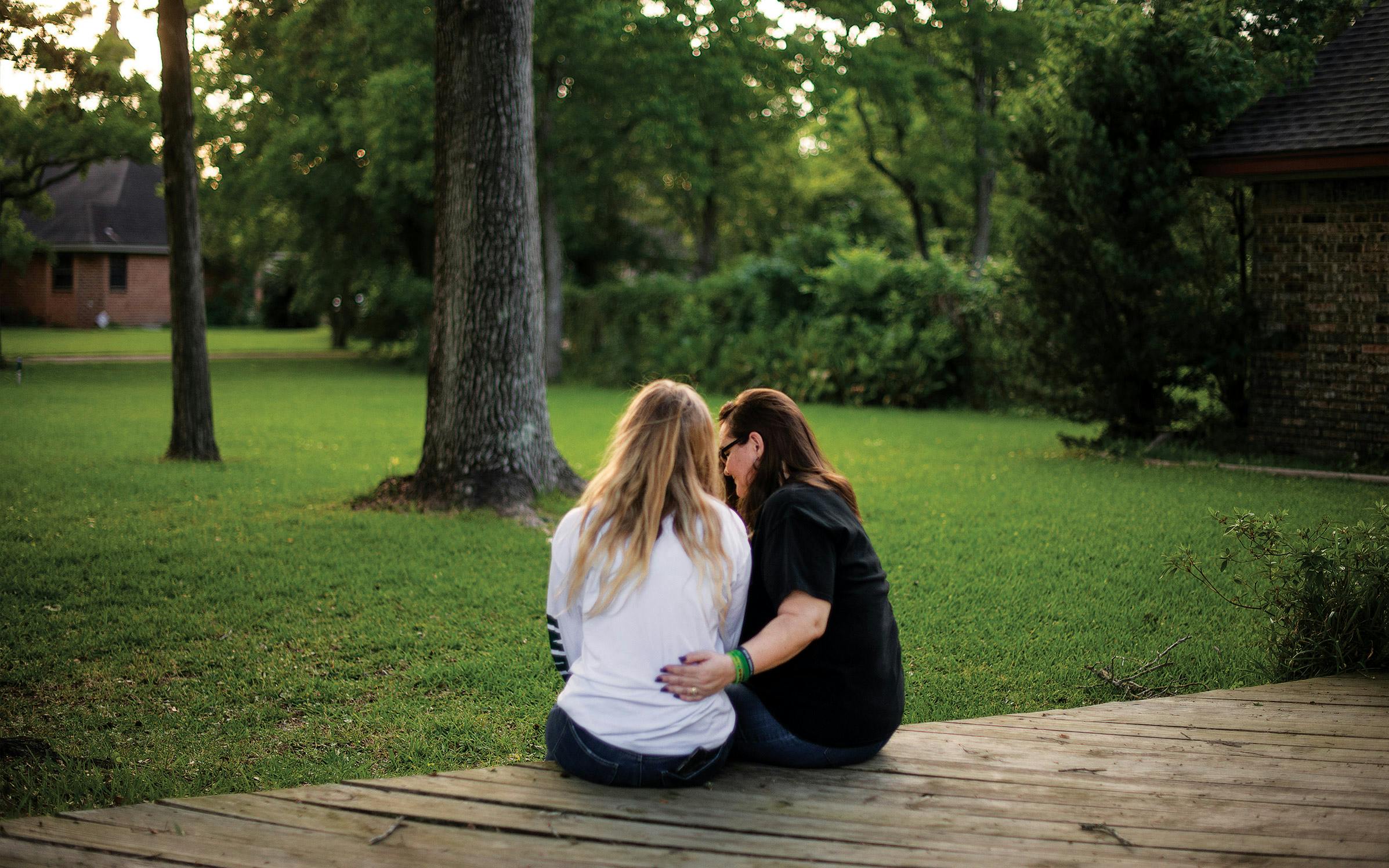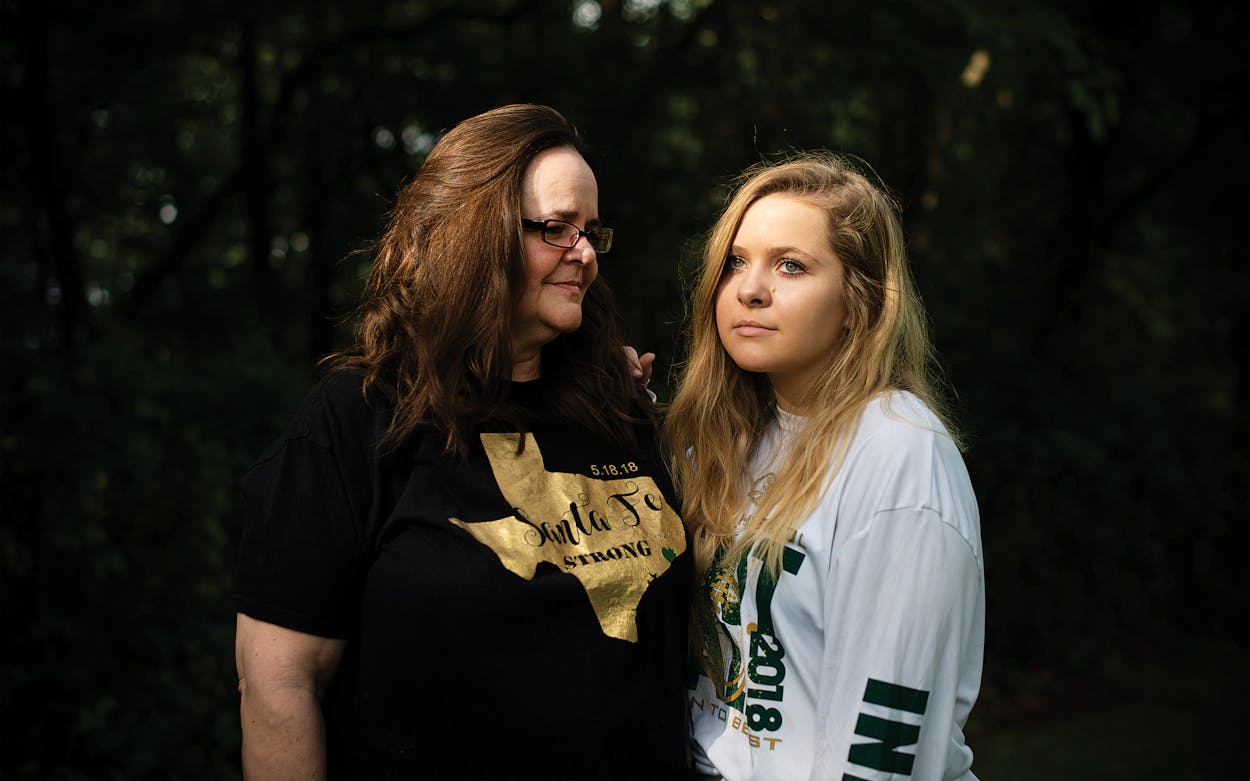Nine months after Hurricane Harvey, the Laymances were still doing renovations on their flooded home. Their walls had a fresh coat of paint, they had new floorboards, and new plush brown couches had just arrived. Life was starting to feel almost normal again. Then, one May morning, fifteen-year-old Isabelle Laymance phoned her mother, Deedra Van Ness, from Santa Fe High School to say she was taking cover from a shooter.
“Mom, they’re shooting up the school,” Isabelle whispered into the phone. Deedra, who had just returned home from dropping Isabelle off, heard gunshots in the background. “I’m hiding in a closet. I love you.”
For forty minutes, Isabelle and eight other students lay on the floor of a supply closet that connects two art classrooms. The shooter taunted them and sang “Another One Bites the Dust” as he shot through a small window in the door, killing several of the teenagers.
As Deedra and her husband, Kenny Laymance, sped to the school in their Chevy Trax, they saw other parents abandoning their cars on the highway and running toward the campus. Kenny was ready to do the same, but Deedra held him back. They started to argue: “He wants to get out and rush to the school,” Deedra later recounted. “And I’m screaming at him, ‘No, stop it. You’re going to distract the officers. Let them do their job and save our daughter.’”
After the alleged shooter surrendered to police, officers led Isabelle, covered in other people’s blood and dust from blasted drywall, out of the school. Ten people, eight students and two teachers, were killed at Santa Fe High School on May 18, 2018. Dimitrios Pagourtzis, who was a junior when he allegedly brought a shotgun, pistol, and explosives to the school and began firing on his classmates, is in a state hospital after being declared incompetent to stand trial.
In the days following the shooting, the country digested the stats—ten dead and thirteen injured—and soon moved on to other, deadlier mass shootings. But there are countless others whose lives were irrevocably changed that day. When Deedra and Kenny returned home with Isabelle, all the priorities, expectations, and worries they had before were swept aside.
Isabelle walked away from the shooting without a scratch, but she has returned to the closet time and again in nightmares and during panic attacks. The trauma has stayed with her like a wound that won’t heal, and has spread out to each member of her family—her mom, dad, and three older brothers, who had all finished high school—in different ways. The debate Deedra and Kenny had in the car as they waited to hear from Isabelle has played out continually. Kenny, who was diagnosed with PTSD himself, has succumbed more to his emotions, often breaking into tears and growing frustrated with his inability to help Isabelle. Deedra has tried to be pragmatic and a lifeline for her daughter, a round-the-clock responsibility that has cost her friends and affected her work performance.
Two years later, most of what the Laymances were able to salvage from the first floor after the hurricane is still in boxes and tags remain on the furniture. Recently, Deedra looked up from the sink while she was washing her hands and noticed that she never got around to hanging a mirror in the bathroom.
“After everything that happened, we just quit,” Deedra, 52, told me. “We aren’t the people that we were before that day.”

I met Isabelle at her house hours after the shooting. By then she had showered and changed into a long-sleeve gray shirt, shorts, and pink ankle socks patterned with orange hearts. Her voice remained even and her face blank as she, evidently in shock, described how one of the boys, shot in the head, had slumped over unnaturally.
As the day went on and countless cable news anchors drew comparisons between Santa Fe and Columbine, Isabelle, a freshman at the time, googled the infamous 1999 shooting. She learned that just like the alleged Santa Fe shooter, the Columbine shooters wore trench coats, brought bombs to the school, and taunted hiding students. For the next month, she researched major mass shootings, trying to find out if others had gone through what she had.
Isabelle began showing signs of post-traumatic stress disorder the day after the shooting when she went with her mom to pick up her backpack from the junior high school.
“Do I have to take the backpack?” she asked. “There’s probably blood on it.”
It wasn’t until after they arrived that they found out belongings left in the art rooms weren’t yet being released by investigators. In the front hallway of the school, everyone seemed to know she was one of the kids in the art rooms. As friends and parents descended on her offering hugs and peppering her with questions, Isabelle’s whole body tensed and she froze in place. Her green eyes unfocused like someone had flipped a switch and turned her off.
The family rarely left their home after that. Isabelle became hypersensitive to noises and learned to recognize the sounds of her family members’ footsteps, so she could always tell when someone new was at the house.
She grew a lot more confrontational, cutting off friends who she felt had abandoned her. She stopped talking to the girl who had been her best friend since fifth grade.
“I have less patience for everything,” Isabelle told me later.
“Plus everybody’s a little frightened of her,” Deedra added.
“They should be,” Isabelle said. “People don’t really talk to me because I just give off that vibe of not to talk to me.”

The Santa Fe High school year was cut short by the shooting, and the community spent the summer of 2018 trying to rebound. The city set up a counseling center at a local Methodist church, a nonprofit started designing a therapeutic garden for the community, and Governor Greg Abbott invited victims and their families to participate in roundtable discussions about school safety.
During that first summer, Kenny, 57, found himself tearing up at songs on the radio and commercials featuring fathers and daughters. In the months before the shooting, life had taken more than a few swings at him: he suffered from seizures that prevented him from driving and forced him to leave his job as an inspector of refineries. But the crying was new and his sudden bursts of emotion both worried and frustrated him. “I’m the life of the party. I’m always happy,” he said a year after the shooting, adding that now he cries “too much.”
Kenny was also having trouble concentrating, and it was taking him longer than normal to complete household repairs and tasks. He had to attend counseling as part of his application for Supplemental Security Income benefits and, to his surprise, was diagnosed with PTSD. Waiting to hear if Isabelle was alive and unharmed, and then watching her struggle to cope in the aftermath, had been its own trauma.
Kenny grew mad—that he couldn’t drive anymore, that he couldn’t work, and, most of all, that he couldn’t do anything to lessen Isabelle’s pain. Deedra had to remind him that while he had every right to his anger, he was not the only one feeling it. She went from having only one more kid left to graduate to having one who may never feel like she can leave home. And now she had a disabled husband who would need her more and more.
“This picture of freedom that I thought I had coming is gone,” Deedra said months after the shooting.
She became the family’s designated caretaker. Between Kenny, Isabelle, and herself, they were going to therapy three or more times per week. (Her youngest son, Kamrin, now nineteen and living at home, refuses counseling.)
As the sole breadwinner, Deedra couldn’t stop working as an insurance auditor, but she was taking more and more time off and it took longer to finish each audit. Her social life faltered as she struggled to be around people who didn’t understand what she was going through. She didn’t want to be a burden on them, which left her calculating the cost of each conversation before she entered it. She would ask herself, Does this person want to hear about my problems? “When was the last time I talked to them? Have I dumped on them lately?”
“Even when I see people, it’s hard for me to connect anymore because I don’t have the same life they do,” Deedra told me. “My life revolves around my children, my husband, and my job and that’s it. I don’t do anything else.”


Isabelle went back and forth all summer trying to decide whether she wanted to go back to Santa Fe High for her sophomore year. She wanted to be around her friends and her boyfriend, and she wanted to continue bowling on the school’s varsity team. Deedra hoped that going back would help Isabelle overcome her fears.
“I didn’t want that to be something hanging over her,” Deedra later said.
The school added four new counselors to help address the students’ emotional needs, but their offices were located in the newly renovated hallway where the shooting occurred. Burnt orange tiles were randomly dispersed among the otherwise tan floor, which reminded Isabelle of puddles of blood.
Each day brought a barrage of panic attacks that made Isabelle feel like she was dying and often left her in tears. “I feel my chest closing in,” she texted Deedra at 9 a.m. three days into the new school year.
Deedra tried to help her calm down using the techniques Isabelle learned in therapy over the summer. She started by asking questions. What happened? What triggered you? Is it still there? Then she told her to take a deep breath, hold it for five seconds, and exhale until there was no air left in her lungs, like she was blowing out birthday candles.
“It’s not helping,” Isabelle responded. “I feel like one of those is going to be my last breath.”
Deedra next told her to identify five things she could see, smell, touch, taste, and hear.
After twenty minutes, Isabelle was still struggling and Deedra asked if she wanted to come home.
“I wanna say yes, but I feel weak if I do,” Isabelle replied.
“No, never weak,” Deedra said. “I’m on my way.”
Isabelle ended up missing more than one hundred days her sophomore year and left early many others, even after switching to a reduced schedule. She wasn’t the only student struggling. One of her friends, who wasn’t at school on the day of the shooting, still had anxiety about attending and missed more than eighty days; another dropped out entirely.

Six months after the shooting, as other families in Santa Fe were counting down the days to Thanksgiving break, Isabelle was frustrated that her antidepressants were making her feel numb. When her pet turtle died, she didn’t even cry.
Isabelle stopped taking her medication, and quickly fell into a deep depression and became suicidal. “I wanted to slit my whole body up, and I wanted to tie a noose and hang myself with it,” Isabelle said months later. When she told her parents, they took her to the hospital for a psychiatric evaluation and helped her get back on her medication.
Isabelle experiences survivor’s guilt. She wonders if she could have made more space on the floor of the closet for someone to lie down flatter. In intensive therapy, she was once asked to return to the closet in her mind, and think about what would have happened if she was the one who was blocking the door instead of the boy she saw die in front of her. The idea was that by returning to the day of the shooting, she could see that there was nothing different she could have done.
One day last summer, more than a year after the shooting, I met with Isabelle at her house. Her blond hair was piled on top of her head in a bun, and she was sprawled out on the couch. As our interview wrapped, Isabelle pointed to the armadillo tattoo on my ankle. “Did your tattoo hurt?”
Before I could answer, Deedra cut in. “You’re not getting a tattoo.”
“My mom won’t let me get a tattoo this big,” Isabelle said, holding her thumb and forefinger about an inch apart. She wanted to get a semicolon on her wrist, a symbol of solidarity with those who are struggling with mental illness.
Deedra said she could get it when she moved out.
“But I’m not moving out,” Isabelle retorted. “The second I turn eighteen I’m getting all my piercings that I want, I’m getting all the tattoos that I want, and I’m going to stay here and I’m going to show her all of them.”
“She’s gonna be living in my yard,” Deedra joked, adding that some kids at the high school got tattoos to commemorate the shooting.
Isabelle said she wanted one of those too—“5/18/18” in Roman numerals—but her mom wouldn’t allow that either.
“Do you really want to carry that physically with you your whole life? And have to explain it to people over and over?” Deedra asked.
“I will explain it to people over and over,” Isabelle said. “It made me who I am today.”

Isabelle returned to school for her junior year in 2019 as normal, but less than a month in, she left and enrolled in homeschool. At home, Isabelle was having significantly fewer panic attacks, and without the constant stress of school, she felt like she could manage her anxiety on her own. She even reconnected with one of the old friends she had a falling out with. She decided to stop taking her antidepressants again—this time under the supervision of her parents and doctors.
The Santa Fe community was outraged when, in mid-November, a judge declared the shooter incompetent to stand trial. For many, it was another delay in their quest for closure. Deedra broke the news to her family, reminding them that he was still locked away and couldn’t hurt them.
Soon after, Isabelle drove past a memorial of ten white crosses bearing the names of those killed in the shooting, and she began having a panic attack. She pulled over. This was new: she’d never had such a hard time catching her breath before. As she struggled to draw in oxygen, she blacked out. The experience terrified and exhausted her. She made it home and slept for fifteen hours. Why, she wondered, was it so much worse than before?
Deedra reminded her that her medication had previously served as a buffer between her and her anxiety. “You’re feeling it completely,” Deedra told her.
“I don’t know why you sent me to counseling for all that time,” Isabelle told Deedra. “I don’t think it did anything.”
Without realizing it, Isabelle had internalized the coping mechanisms she learned during sixteen months of weekly therapy.
Deedra laughed. “It made those things a habit. How to calm yourself, how to react, how to get your body back in control,” Deedra told her. “Those are not things you have to think about anymore. You just automatically do them now.”
In March, panic over the coronavirus began to ramp up in Texas. Isabelle had been studying from home for most of the year, and quarantine didn’t mean much of a change to the family’s daily life. But messages of fear and uncertainty triggered her anxiety. She asked Deedra to set up an online appointment with her therapist. It was her first counseling session of 2020.
To pass time in quarantine, Isabelle has started painting acrylic landscapes: starry nights over pine trees, a silhouetted deer in front of an orange sunset. The Laymances also spent a month hunched over a table working on a puzzle depicting a lighthouse, before realizing, as they finished filling in the blue sky, that there was a piece missing.
Days before the second anniversary of the shooting, Kenny decided to get away for a “guys weekend.” He’s still frustrated by how often he cries, but he’s learning that it helps to let his feelings out: earlier in the month when the best man at his and Deedra’s wedding died, Kenny walked out into the yard and broke down crying. At home, he told me, he’s learned “to go into my man cave and just let it go.”
Deedra and Isabelle are heading to a remote lodge in the Hill Country for the anniversary. Isabelle’s anxiety is ramping up as the day draws nearer. She’s revisited the white memorial crosses and has been sobbing every day.
Earlier this month, Isabelle, now seventeen, wrapped up her classes. For the third summer in a row, she is debating whether to return to Santa Fe High next year. Her mental health has improved, but she’s been lonely. She spends almost all her time when she isn’t painting watching TV, sleeping, or rearranging the furniture in her room to fight boredom. She wants to be around friends again and participate in the milestones of senior year, like prom and graduation.
Before the shooting, Isabelle was hoping to secure a bowling scholarship to attend college, but now she doesn’t feel like she can stray far from home or her mom. Deedra hopes that one day her daughter will feel safe enough to explore the world uninhibited. She hopes Kenny finds peace. She’s not sure what the future holds for her.
“This is our life,” Deedra said. “Here we are two years later. We’re still navigating, but we’re a lot more hopeful.”






